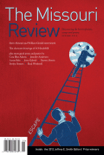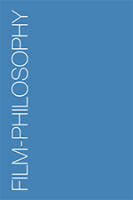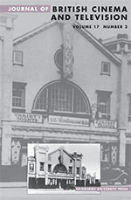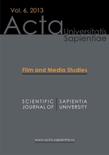
Short Film Studies
Scope & Guideline
Advancing Scholarship in Brief Film Narratives
Introduction
Aims and Scopes
- Critical Analysis of Short Films:
The journal focuses on in-depth critiques of short films, examining narrative structures, aesthetic choices, and thematic content. - Interviews with Filmmakers:
It features conversations with filmmakers, providing insights into their creative processes, influences, and the challenges they face within the short film medium. - Exploration of Genre and Form:
The journal investigates various genres and forms of short films, including experimental, documentary, and narrative shorts, highlighting their unique storytelling techniques. - Cultural and Historical Contexts:
Short Film Studies contextualizes short films within broader cultural, social, and historical frameworks, analyzing how they reflect and influence societal issues. - Innovative Methodologies:
The journal employs diverse methodologies including textual analysis, visual studies, and ethnographic approaches to understand the impact of short films.
Trending and Emerging
- Cultural Specificity and Hybridity:
There is an increasing focus on genre hybridity and cultural specificity, as seen in studies addressing the intersection of different cultural narratives within short films. - Documentary and Realism:
A rising interest in documentary filmmaking and realist portrayals in short films reflects a broader societal engagement with authenticity and representation. - Intersectionality in Film:
Themes exploring race, gender, and class dynamics are becoming more prominent, showcasing the importance of intersectional analysis in understanding short films. - Ecological and Ethical Themes:
Emerging themes related to ecology and ethical storytelling indicate a growing awareness of environmental issues and social responsibility within short filmmaking. - Digital and Technological Innovations:
The impact of digital technologies on short film production and distribution is increasingly recognized, reflecting changes in how films are made, shared, and consumed.
Declining or Waning
- Traditional Narrative Structures:
There appears to be a decreasing focus on conventional narrative forms within short films, as contemporary works increasingly embrace non-linear and experimental storytelling. - Focus on Technical Aspects:
Previous emphasis on technical analysis, such as cinematography and editing techniques, has diminished, with more emphasis now placed on thematic and cultural analysis. - Genre-Specific Studies:
There is a noticeable decline in papers dedicated to specific genres, as the journal shifts towards more interdisciplinary and hybrid approaches to film analysis. - Historical Studies of Early Short Films:
Interest in the historical analysis of early short films is waning, possibly due to a shift towards contemporary works and current trends in short filmmaking. - Regional Film Studies:
The examination of short films from specific regions or countries has seen reduced attention, as the journal increasingly adopts a global perspective on film studies.
Similar Journals

Missouri Review
Where Emerging Voices Meet Established Thought.The Missouri Review, published by the University of Missouri, College of Arts and Science, is a prominent literary journal that serves as a platform for innovative and diverse voices in literature and literary theory. Established as a key publication within the United States, it holds an ISSN of 0191-1961 and an E-ISSN of 1548-9930, reflecting its reach in both print and digital formats. With a current ranking in the Q4 quartile for the year 2023, the journal is positioned in the lower echelon of the literature field as per Scopus rankings, emphasizing the growth potential for emerging scholars and established authors alike. The Missouri Review actively contributes to the scholarly discourse in literature, aiming to enhance understanding through the publication of original short stories, essays, and poetry that challenge and refine literary conventions. Researchers, professionals, and students interested in contemporary literary developments and trends should consider this journal a vital resource for insights and inspiration.

Cine Documental
Unveiling Stories: The Intersection of Film and SocietyCine Documental is a prominent academic journal dedicated to the exploration of documentary cinema, encompassing a wide range of topics from historical analyses to contemporary critiques and theoretical frameworks. Published by CINE DOCUMENTAL, this journal provides an essential platform for researchers, filmmakers, and enthusiasts in the field of film studies, particularly focusing on the vital role that documentary plays in reflecting and shaping societal narratives. With an ISSN of 1852-4699, Cine Documental invites contributions that engage with both traditional and avant-garde documentary forms, fostering dialogue and innovation within the discipline. Although currently not operating under an open-access model, this journal is committed to maintaining a rigorous peer-review process, ensuring the quality and relevance of published works. Located in Buenos Aires, Argentina, and catering to a global audience, Cine Documental stands as a significant contributor to the advancement of film scholarship, making it an invaluable resource for students, academics, and professionals alike.

Film-Philosophy
Fostering Multidisciplinary Dialogues in Film and ThoughtFilm-Philosophy is an esteemed academic journal published by Edinburgh University Press, specializing in the intersection of film studies and philosophical discourse. Since its launch in 1998, this Open Access journal has provided a platform for scholarly debates and innovative research, allowing for free and unrestricted access to its content, which has significantly contributed to the global dialogue on visual culture. With a commendable impact illustrated by its Q1 ranking in Visual Arts and Performing Arts and Q2 in Philosophy, the journal sits within the top quartile of its field. Operating from the United Kingdom, Film-Philosophy is committed to fostering a multidisciplinary approach, inviting contributions from researchers, professionals, and students alike. By engaging with critical theories and the aesthetics of cinema, the journal stands as a vital resource for understanding the philosophical implications of film and its cultural significance.

Studies in Documentary Film
Fostering Interdisciplinary Insights in Documentary FilmStudies in Documentary Film is a prominent academic journal published by Routledge Journals, Taylor & Francis Ltd that delves into the rich intersection of documentary filmmaking and critical academic discourse. With an ISSN of 1750-3280 and an E-ISSN of 1750-3299, this journal has emerged as a key resource for researchers, professionals, and students interested in the impact and evolution of documentary forms in contemporary culture. Recognized within the top tier of journals in Visual Arts and Performing Arts, achieving a Q1 ranking, it also holds a respectable Q3 classification in Communication, making it a vital platform for interdisciplinary dialogue. The journal boasts an impressive Scopus ranking of Rank #87/667 in Visual Arts and Performing Arts and an 87th percentile ranking, highlighting its significant influence and contribution to the field. Operating from the United Kingdom, the journal covers a diverse array of topics related to documentary film theory, practice, and cultural implications, inviting contributions that push the boundaries of traditional and contemporary research. While it does not offer open access, the journal's rigorous editorial standards ensure high-quality, peer-reviewed articles that resonate well with an academic audience committed to the study of documentary film.

Journal of British Cinema and Television
Unveiling the Cultural Impact of Screen NarrativesJournal of British Cinema and Television, published by Edinburgh University Press, is a leading academic journal that explores the dynamic interplay between British cinema and television within the context of cultural studies. With an ISSN of 1743-4521 and E-ISSN of 1755-1714, this journal provides a platform for scholarly discourse, enabling researchers, professionals, and students to engage with critical analyses of screen media and its socio-political impact. As a Q3 journal in Communication and a Q1 journal in Visual Arts and Performing Arts for 2023, it occupies an influential position, particularly in the Arts and Humanities, where it ranks in the 90th percentile. The journal's scope encompasses a wide range of topics, from historical perspectives to contemporary practices in British visual culture, making it essential reading for anyone interested in the evolution and significance of screen studies in the UK. While it is not an open-access publication, the rigorous peer-review process ensures high academic standards and contributes to its esteemed reputation in the field. As it continues to converge from 2004 to 2024, the Journal of British Cinema and Television remains a vital resource for those seeking to deepen their understanding of British media and its global resonance.

POSITIF
Celebrating Creativity: A Platform for Artistic ScholarshipPOSITIF is a distinguished journal, published by POSITIF EDITIONS, focusing on the dynamic fields of Visual Arts and Performing Arts. With ISSN 0048-4911, this journal has been a significant contributor to the arts community since its establishment in 2002, and it continues to captivate readers with its upcoming issues projected until 2024. Based in the heart of France at 12 RUE PIERRE ET MARIE CURIE, 75005 PARIS, POSITIF serves as an invaluable platform for researchers, professionals, and students alike, promoting innovative discourse and critical analysis within the arts. Despite holding a Q4 category ranking in the 2023 classification and a Scopus rank of 637/667, its commitment to enhancing the understanding and appreciation of visual and performing arts remains steadfast. Researchers are invited to contribute to this growing body of knowledge, enriching the journal's scope and impact in a vibrant artistic landscape.

FILM CRITICISM
Advancing the Art of Film AnalysisFILM CRITICISM is a prestigious open-access journal dedicated to the study and review of cinema, offering a platform for scholars, critics, and students to engage deeply with the evolving landscape of film. Published by Film Criticism and based in the United States at Allegheny College, this journal has been contributing to film studies since 2002, with recent issues spanning from 2023 to 2024. Registered under ISSN 0163-5069, it is recognized in the Visual Arts and Performing Arts categories, achieving a commendable rank of #372 out of 667 in Scopus, placing it in the 44th percentile of its field. With an open-access policy implemented since 2016, FILM CRITICISM not only broadens accessibility to scholarly work but also enhances the dialogue around cinematic narratives, theories, and critiques. The journal's relevance is underscored by its current Q3 ranking, making it an essential resource for researchers and professionals alike who are invested in the critical examination of film.

Junctures-The Journal for Thematic Dialogue
Illuminating contemporary issues through interdisciplinary dialogue.Junctures: The Journal for Thematic Dialogue is a distinguished academic platform published by Otago Polytechnic - Te Kura Matatini Ki Otago, based in New Zealand. With the ISSN 1176-5119 and E-ISSN 1179-8912, this journal offers a unique scope that encompasses cultural studies, literature, and the visual and performing arts, providing a critical space for scholars and practitioners to explore interdisciplinary thematic dialogues. Despite being categorized in the lower quartiles of the 2023 Scopus rankings, the journal serves as an important venue for emerging voices in the arts and humanities, facilitating innovative discussions around contemporary cultural issues. While currently not an open access journal, it remains dedicated to fostering scholarly engagement and thought-provoking discourse, enhancing the academic landscape from 2009 to 2012, and again from 2015 to 2020, with a resurgence in 2022 to 2023. Researchers, professionals, and students alike will find in Junctures a valuable resource for advancing the understanding and appreciation of the arts and culture.

Acta Universitatis Sapientiae-Film and Media Studies
Connecting Scholars through Open Access KnowledgeActa Universitatis Sapientiae-Film and Media Studies is a distinguished journal dedicated to the exploration of film and media within the broader context of cultural studies. Published by SCIENDO, this journal has been an essential resource for researchers, professionals, and students since it adopted an Open Access model in 2013, facilitating worldwide accessibility to cutting-edge scholarship. With its ISSN 2065-5924 and E-ISSN 2066-7779, Acta Universitatis Sapientiae aims to publish high-quality, peer-reviewed articles that promote innovative research and critical discourse in film and media studies. Located in Warsaw, Poland, and contributing to the international academic community, this journal provides a platform for interdisciplinary dialogue and the examination of emerging trends in media practices, theories, and technologies. By encouraging diverse perspectives, it not only enriches the academic landscape but also nurtures the next generation of scholars in this dynamic field.

MILLENNIUM FILM JOURNAL
Connecting Scholars and Practitioners in Film Exploration.MILLENNIUM FILM JOURNAL, published by MILLENNIUM FILM WORKSHOP INC, stands as a pivotal platform for exploration and discourse within the realm of film studies. With its ISSN 1064-5586, the journal has been noteworthy in delineating the complexities of visual arts and performing arts, contributing significantly to academic scholarship between the years 2009 to 2016, and in 2018. Though its coverage has been discontinued in Scopus, the journal has attained a respectable position within its category, ranking #320 out of 502 in the Arts and Humanities field. Researchers, professionals, and students alike are invited to engage with interdisciplinary discussions that illuminate the cultural and theoretical dimensions of cinema. While currently not offering open access options, the journal continues to serve as a vital resource for those deeply invested in the study of film, making it a respected voice in visual arts and performance research.